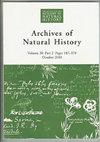捷克共和国Broumov本笃会修道院的Johann Brehe的Hortus siccus(1595),重新发现
IF 0.3
4区 哲学
Q3 HISTORY & PHILOSOPHY OF SCIENCE
引用次数: 0
摘要
一个被遗忘的文艺复兴时期的植物标本室可以追溯到1595年。它与乌尔姆的博物学家Hieronymus Harder(1523-1607)创建的植物标本馆有关。这株花束最近在捷克共和国布劳莫夫(布劳瑙)的布劳莫夫斯卡博物馆被发现,它来自当地本笃会修道院的收藏。这是捷克共和国已知的最古老的花束。它包含358个标本以及注释和绘图。它的创造者是来自Überlingen的Johann Brehe,一个16世纪的理发师。文章分析了物种的表示、注释的目的,以及补充标本的插图的意义。它还调查了Brehe的工作和Harder与植物标本馆有关的活动之间的联系。Brehe的植物标本馆与两个类似的藏品进行了比较;约翰·雅各布·汉(? 1565-1616)1594年的植物标本室和哈德的植物标本室,也是1594年的,都保存在Überlingen。它与两者有一些共同的特征,但在其他方面有所不同。特别地,我们比较了来自新大陆的植物和苔藓和地衣的代表。最后,我们讨论了一个在康斯坦茨湖岸边的小镇上创建的植物标本馆是如何进入东波西米亚修道院的问题,在那里,它的存在最早是在1937年由Pater Vincenz Maiwald OSB(1862-1951)记录的。我们还强调捷克修道院作为处理自然科学和社会科学的重要未发表文件的来源的重要性。本文章由计算机程序翻译,如有差异,请以英文原文为准。
Hortus siccus (1595) of Johann Brehe of Überlingen from the Broumov Benedictine monastery, Czech Republic, re-discovered
A forgotten Renaissance herbarium dated to 1595 is described. It is connected to herbaria created by the naturalist Hieronymus Harder (1523–1607) of Ulm. This hortus siccus was recently found in the Muzeum Broumovska, Broumov (Braunau), Czech Republic, to which it came from the collections of the local Benedictine monastery. It is the oldest hortus siccus known in collections in the Czech Republic. It contains 358 specimens as well as annotations and drawings. Its creator was Johann Brehe from Überlingen, a sixteenth-century barber-surgeon. The paper analyzes the representation of species, the purpose of the annotations, and also the meaning of the illustrations which supplement some of the specimens. It also investigates connections between Brehe’s work and Harder’s activities linked to herbaria. Brehe’s herbarium is compared with two similar collections; Johann Jakob Han’s (?1565–1616) herbarium of 1594 and Harder’s herbarium, also of 1594, and both kept in Überlingen. It shares some features with both, while differing in other respects. In particular, we compare representations of plants from the New World and the inclusion of mosses and lichens. Finally, we address the question of how a herbarium created in a town on the shores of Lake Constance, in present-day Germany, found its way to an eastern Bohemian monastery, where its presence was first documented as recently as 1937 by Pater Vincenz Maiwald OSB (1862–1951). We also highlight the importance of Czech monasteries as sources of important, unpublished documents dealing with both the natural and social sciences.
求助全文
通过发布文献求助,成功后即可免费获取论文全文。
去求助
来源期刊

Archives of Natural History
HISTORY & PHILOSOPHY OF SCIENCE-
CiteScore
0.40
自引率
50.00%
发文量
34
审稿时长
>12 weeks
期刊介绍:
Archives of Natural History (formerly the Journal of the Society for the Bibliography of Natural History) publishes peer-reviewed papers on the history and bibliography of natural history in its broadest sense, and in all periods and all cultures. This is taken to include botany, general biology, geology, palaeontology and zoology, the lives of naturalists, their publications, correspondence and collections, and the institutions and societies to which they belong. Bibliographical papers concerned with the study of rare books, manuscripts and illustrative material, and analytical and enumerative bibliographies are also published.
 求助内容:
求助内容: 应助结果提醒方式:
应助结果提醒方式:


